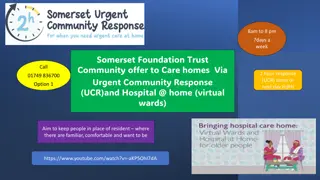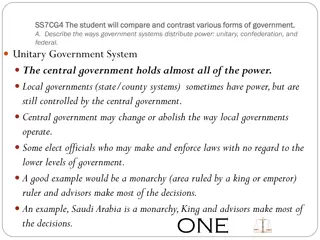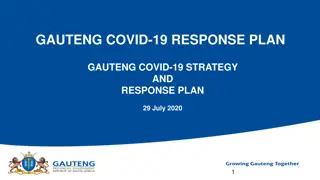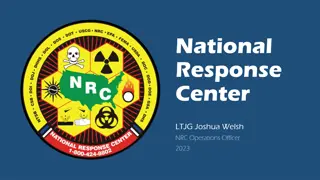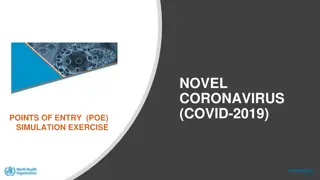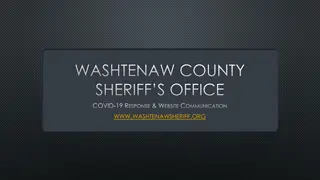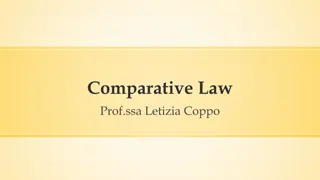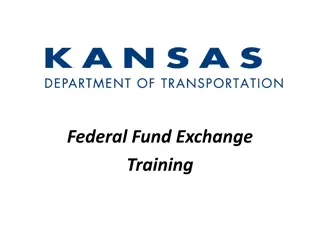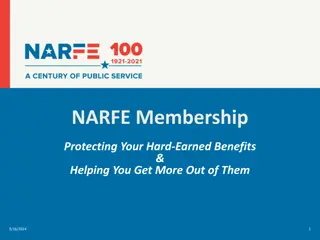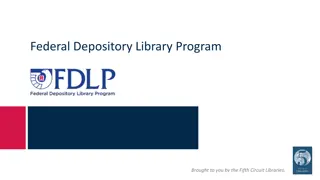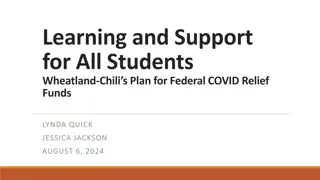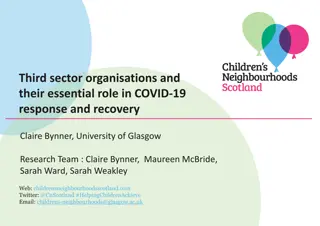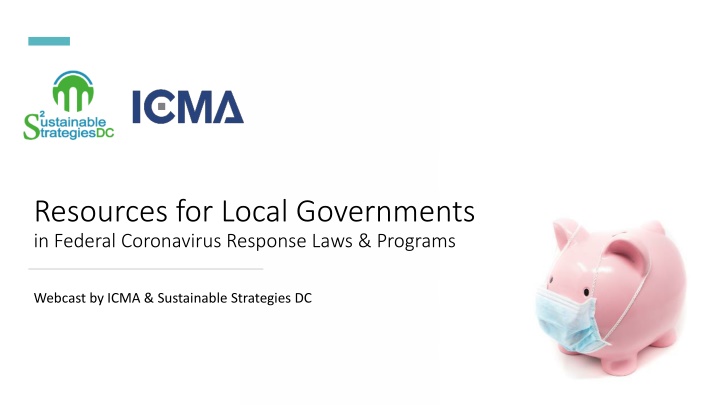
Strategies for Accessing Federal Funding Opportunities in Response to COVID-19
Explore federal legislative packages and funding opportunities for local governments in response to the COVID-19 pandemic. Learn about key laws, programs, and tips for securing resources effectively. Stay informed and engaged in navigating the current crisis.
Download Presentation

Please find below an Image/Link to download the presentation.
The content on the website is provided AS IS for your information and personal use only. It may not be sold, licensed, or shared on other websites without obtaining consent from the author. If you encounter any issues during the download, it is possible that the publisher has removed the file from their server.
You are allowed to download the files provided on this website for personal or commercial use, subject to the condition that they are used lawfully. All files are the property of their respective owners.
The content on the website is provided AS IS for your information and personal use only. It may not be sold, licensed, or shared on other websites without obtaining consent from the author.
E N D
Presentation Transcript
Funding Opportunities by Sustainable Strategies DC ICMA Brand Logos and Assets | icma.org Resources for Local Governments in Federal Coronavirus Response Laws & Programs Webcast by ICMA & Sustainable Strategies DC
Presenters Beth Kellar, Director of Public Policy, ICMA Matt Ward, CEO, Sustainable Strategies DC Ashley Badesch, Principal, Sustainable Strategies DC Funding Opportunities by Sustainable Strategies DC ICMA Brand Logos and Assets | icma.org
How to Participate Effectively All participants on mute To ask a question, type in lower box of your dashboard This webcast will be recorded and sent to all participants and others who wish to review it Most importantly stay in touch and follow up!
Presentation Outline Overview of Federal Coronavirus Legislative Packages to Date 10 Tips for Organizing Effectively to Secure COVID-19 Resources Resources for Local Governments in Federal COVID-19 Response Programs What s Next?
Overview of Federal Coronavirus Legislative Packages to Date Funding Opportunities by Sustainable Strategies DC ICMA Brand Logos and Assets | icma.org
Coronavirus Preparedness and Response Supplemental Appropriations Act (H.R. 6074), became law 3/6/2020 Family First Coronavirus Response (H.R. 2601), became law 3/18/2020 Coronavirus Aid, Relief, and Economic Security (CARES) Act (H.R. 748), became law 3/27/2020 COVID-19 Federal Legislative Packages Summary of Local Government Resources
Coronavirus Preparedness and Response Supplemental Appropriations Act (H.R. 6074) Provides FY2020 supplemental appropriations to respond to the coronavirus outbreak Funds programs to: Develop, manufacture, and procure vaccines and other medical supplies Offer grants for state, local, and tribal public health agencies and organizations Provide loans to affected small businesses Launch evacuations and emergency preparedness activities across the globe Provide humanitarian assistance and support for health systems affected countries Link to full text; link to summary
Family First Coronavirus Response (H.R. 6201) Insurance/Medicaid/CHIP resources and mandates Mandates for paid and family sick leave, including by public agencies Funding relief provided by legislation for private sector for mandated sick/family leave is not provided for public sector agencies Unemployment insurance resources Resources for SNAP/WIC, SNAP flexibilities, Emergency SNAP, School Lunch assistance, Emergency Food Assistance, Senior Nutrition, more Link to full text; link to summary
CARES Act (H.R. 748) $2.2 trillion aid package that provides financial aid to families, governments, and businesses impacted by the COVID-19 public health crisis, including: $290 billion in direct payments to eligible taxpayers $260 billion in expanded unemployment insurance $150 billion for state and local governments $510 billion in expanded liquidity lending for businesses and local governments $377 billion in new loans and grants for small businesses $127 billion for hospitals for ventilators and other equipment Link to full text; link to summary
10 Tips for Organizing Effectively to Secure COVID-19 Resources Funding Opportunities by Sustainable Strategies DC ICMA Brand Logos and Assets | icma.org
10 Tips for Effectively Organizing to Secure COVID-19 Resources 1) Organize a task force to coordinate local needs, resources, and messaging 2) Track local resources dedicated to COVID-19 response Direct spending on first responders, PPE, communications, utilities, etc. 3) Track lost revenues Decline in taxes, service charges, fees 4) Identify top priority funding needs & projects 5) Align priority projects and funding needs with available resources
6) Generate briefing sheets and talking points for priority projects and funding needs 10 Tips for Effectively Organizing to Secure COVID-19 Resources 7) Coordinate with Governor s Office, state and county health departments, and other key agencies; create contact list of federal- state-local chain of command 8) Communicate your challenges to congressional delegation 9) Distribute handouts to local businesses, non-profit groups, and other local interests to outline available federal and state resources 10) Stay tuned for opportunities to shape aid and infrastructure packages by tracking alerts from ICMA, NLC, USCM, NAACHO, NACo and Sustainable Strategies DC
Resources for Local Governments in Federal COVID-19 Response Programs Public Health & Safety Social Services, Housing, & Community Development Economic Development & Infrastructure Small Business Assistance Local Government Stabilization
$45 billion for a FEMA Disaster Relief Fund plus additional $400 million in federal grants including Assistance to Firefighters, Emergency Management Performance, and Emergency Food and Shelter Program grants $1.5 billion for CDC State and Local Preparedness $850 million for BJA Coronavirus Emergency Supplemental Byrne Grants $955 million for HHS Aging and Disabled program resources and grants $425 million for HHS SAMHSA funding, including Emergency Grants to Address Mental & Substance Use Disorders During COVID-19 $200 million for FCC telehealth program grants Public Health & Safety
FEMA authorized to reimburse local governments for emergency protective measures in response to the COVID-19 pandemic under Category B of FEMA s Public Assistance program: Management, control, & reduction of immediate threats to public health & safety Emergency medical care & sheltering Purchase and distribution of food, water, ice, and other supplies To access resources:Contact your State s designated Public Assistance (PA) Representative to determine if your facilities, work, and costs meet eligibility criteria and receive direct guidance on procedures to secure reimbursement Step by Step PA Program Delivery ICMA Presentation pages 18-29 List of State Emergency Management Agencies FEMA Disaster Relief Funds
$2.2 billion under H.R. 6074 to prevent, prepare for, and respond to COVID-19, with no less than $950 million for grants and cooperative agreements On March 16, CDC awarded $570 million for state/local health responses under HHS Crisis Cooperative Agreements to 65 eligible jurisdictions (50 states, 8 territories, 6 directly funded localities, one tribal nation) Funding for health departments to conduct surveillance, epidemiology, laboratory capacity, infection control mitigation, communications, and other preparedness response activities To access resources: contact your State Health Department For other helpful info for local health departments, visit NAACHO s COVID-19 Resource Center CDC State & Local Preparedness Funds
States, territories, tribes, or units of local government eligible for funding under the FY2019 State & Local Edward Byrne Memorial Justice Assistance Grant program are eligible to apply for supplemental funds, allocated by formula Provides funding to law enforcement to prevent, prepare for, and respond to the coronavirus: Overtime Equipment (law enforcement and medical PPE) Hiring Supplies (gloves, masks, sanitizer) Training Travel expenses for resource distribution Addressing medical needs of inmates in state, local, and tribal prisons, jails, and detention centers To access resources: Communities eligible for local direct award should submit application, including federal SF- 424 forms, narrative, and budget, by May 30, 2020 DOJ FY 2020 Coronavirus Emergency Supplemental Byrne Grants Funding
Social Services: $3.5 billion in Child Care and Development Grants; $1 billion in Community Service Block Grants; $900 million in Low Income Housing Energy Assistance Program (LIHEAP) funding; Housing Assistance: Social Services, Housing, & Community Development $4 billion for HUD Homeless Assistance Grants under Emergency Solutions Grant program $1.25 billion in HUD tenant-based and $1 billion in project-based rental assistance resources $685 million for public housing authority operations Community Development: $5 billion for HUD CDBG grants, with a waiver on the public services cap, and other flexibilities $75 million for National Endowment for the Arts grants and $75 million for National Endowment for the Humanities grants, with 60% of those fund for direct grants to arts agencies (and 40% for state arts and humanities programs)
$4 billion for homeless assistance through the Emergency Solutions Grants (ESG) state and local government formula program Eligible uses: emergency shelter operations, street outreach, expanded staffing, and other services to protect homeless and at- risk populations (below 50% AMI for CARES Act funds) from COVID-19 Eliminates: matching funds, planning, and procurement requirements; cap on shelter funding; and habitability and environmental standards for temporary emergency shelters To access resources: First wave: up to $2 billion under regular ESG formula in 30-day timeframe; second wave: remaining funds distributed based on new HUD formula that accounts for state and local COVID-19 needs HUD Homeless Assistance Grants
$685 million for public housing authorities (PHAs) to take necessary actions and maintain normal operations during COVID-19 $1.25 billion in Section 8 tenant based rental assistance to coronavirus-related matters $850 million for Section 8 administrative and other PHA expenses, including mainstream vouchers $400 million for adjustments to 2020 Section 8 renewal allocations for PHAs that experience COVID-19-related increase in per-unit costs so to avoid terminating families from the program Additional $1 billion for Section 8 project-based rental assistance for owners or sponsors of Section 8 properties to help make up for reduced tenant payments as a result of COVID-19 Enhanced flexibility & broad discretion for waivers To access resources: Coordinate with PHA and State Housing Financing Agency HUD Housing Assistance
$5 billion in CARES ACT for COVID-19 response: $1 billion to states, $2 billion to FY2020 grantees (pushed out April 2), $2 billion directly to states and local governments at discretion of Secretary HUD Community Development Block Grants Expedited process to prepare or modify statement of activities, with 5 days public notice and comment Virtual public hearings allowed for duration of social distancing and limiting public gatherings Buildings and Improvements Assistance to Businesses Broad waiver authority for the HUD Secretary to allow flexibility for eligible uses To Access: Entitlement communities receive by formula Non-entitlement apply to State Community Development Director (often with State Housing Department or Local Affairs) Public services Planning HUD Quick Guide to CDBG Eligible Activities to Support Infectious Disease Response
$1.5 billion for EDA Economic Adjustment Assistance Grants $345 million in DOL Dislocated Worker program resources and community grants; $100 million currently available $25 billion for FTA 2020 CARES Act Supplemental Public Transportation Apportionments and Allocations $10 billion in FAA CARES Act Airport Grants Economic Development, Workforce Development, & Infrastructure
$1.5 billion for EDA Economic Adjustment Assistance (EAA) for COVID-19 prevention and response, including for necessary expenses for responding to economic injury due to COVID-19 COVID-19 Disaster Supplemental NOFO not released; expected 80% federal share, (could be 50%-100%) Long-term, regionally coordinated economic development and disaster recovery projects that create and retain jobs Exp. eligible uses must have nexus to disaster recovery and resilience: creating or updating disaster recovery plans; construction projects; market or industry research studies; technical assistance and capacity-building; capitalization and recapitalization of revolving loan funds (RLFs) to provide loans to small businesses To access resources: Get started now application process takes time Develop a project briefing sheet and reach out to your regional Economic Development Representative to discuss project prior to initiating application process Applications accepted on a rolling basis EDA Economic Adjustment Assistance
FTA released guidelines for the $25 billion in Transit Assistance funding appropriated in the CARES Act Will be allocated to recipients of urbanized area and rural area formula funds; $22.7 billion allocated to large and small urban areas and $2.2 billion allocated to rural areas Will fund 100% of costs (no match required) to support capital, operating, and other expenses generally eligible under the Section 5307 and Section 5311 programs to prevent, prepare for, and respond to COVID-19 Operating expenses incurred beginning January 20, 2020 for all rural and urban recipients are also eligible, including expenses to maintain transit services and paid administrative leave for transit personnel due to reduced operations FTA Transit Assistance Funding
$349 billion in forgivable SBA Paycheck Protection Program loans to small businesses to cover payroll, employee salaries, mortgage interest, rent and utility payments associated with COVID-19 crisis More than $150 billion to expand the SBA Emergency Economic Injury Loan (EIDL) program including $10 billion for new EIDL Emergency Advance grants Small Business Relief & Assistance $192 million for grants to Small Business Development Centers $48 million for no-match grants to Women s Business Centers $10 million for Minority Business Centers Debt relief options for borrowers including automatic payments on principal, interest, and fees of current microloans for a period of six months and new microloans issued prior to September 27, 2020 Link to memo for small businesses
$454 billion Liquidity Loan Program to provide liquidity to eligible businesses, States and municipalities related to losses as a result of coronavirus $150 billion Coronavirus Relief Fund, allocated to governments in states ($139 billion to the 50 states allocated based on population), territories ($3 billion), and tribal areas ($8 billion) State and Local Stabilization
CARES Act appropriates $454 billion to provide liquidity to eligible businesses, States and municipalities related to losses as a result of coronavirus Act provides that the Secretary shall endeavor to seek the implementation of a [Fed] program or facility that provides liquidity to the financial system that supports lending to government borrowers Federal Reserve has not yet released guidance or indication of nature of program On March 20, the Fed separately expanded its facilities to cover certain aspects of municipal debt market by making loans available to eligible financial institutions secured by certain high-quality assets purchased from tax-exempt municipal money market mutual funds Potential for CARES ACT to add to this secondary market and/ or provide direct federal lending to government borrowers Liquidity Loan Program for Municipalities
$139 billion Coronavirus Relief Fund provided to state governments; local governments serving a population of at least 500,000 (most recent census) may elect to receive assistance directly from Treasury Allocated according to population, minimum of $1.25 billion per state Eligible expenditures must be: (1) Necessary and incurred due to COVID-10 public health emergency (2) Not accounted for in budget most recently approved as of date of enactment [March 27, 2020] (3) incurred during the period that begins on March 1, 2020 and ends on December 30, 2020 Coronavirus Relief Fund payments may not be used to directly account for revenue shortfalls caused by COVID- 19; must be new, coronavirus-related expenses State & Local Coronavirus Relief Fund
Members of Congress, governors, and mayors are urging Secretary Mnuchin to develop guidelines for recipients of Relief Fund that are inclusive of all local jurisdictions, speedy in delivery, and flexible in use: Expenditures to ensure continuity of local government Local health department & public health worker COVID-19 expenses Municipal law enforcement, fire department, and paramedic & emergency medical services and worker expenditures associated COVID-19 response, including overtime payment PPE, medical supplies, sanitation supplies & other materials associated with COVID-19 response Social services & homeless assistance during COVID-19 crisis COVID-19 public communications & outreach Costs of municipal utility bill forgiveness, fee waivers, and other unanticipated COVID-19 costs To access resources: Coordinate with Governor s Office to prepare for resources; consider drafting letter to Governor explaining need for resources State & Local Coronavirus Relief Fund, Cont.
Whats Next? Funding Opportunities by Sustainable Strategies DC ICMA Brand Logos and Assets | icma.org
First three federal packages focused on response & relief; now many are calling for stimulus & rebuilding the American economy and communities House Speaker has proposed $770 billion, 5-year infrastructure package for community health centers, clean drinking water, broadband, and transportation including roads, mass transit & rail systems Speaker also calling for additional stabilization funding for state & local government, extended unemployment benefits, additional funding for hospitals, and expanded job protections & benefits for workers. President Trump calling for $2 trillion infrastructure package, focused solely on jobs and rebuilding roads and bridges Prepare to access resources: Compile list of top priority infrastructure projects, evaluate shovel-readiness, confirm costs and timelines Phase 4 Stimulus & Infrastructure Package
Funding Opportunities by Sustainable Strategies DC ICMA Brand Logos and Assets | icma.org Contact Info Matt Ward, CEO Sustainable Strategies DC Mat.Ward@StrategiesDC.com (202) 261-9880 Ashley Badesch, Principal Sustainable Strategies DC Ashley.Badesch@StrategiesDC.com (202) 261-9883 Beth Kellar, Director of Public Policy ICMA ekellar@ICMA.org Tad McGalliard, Director, Research & Team Leader, Business Development ICMA tmcgalliard@ICMA.org

